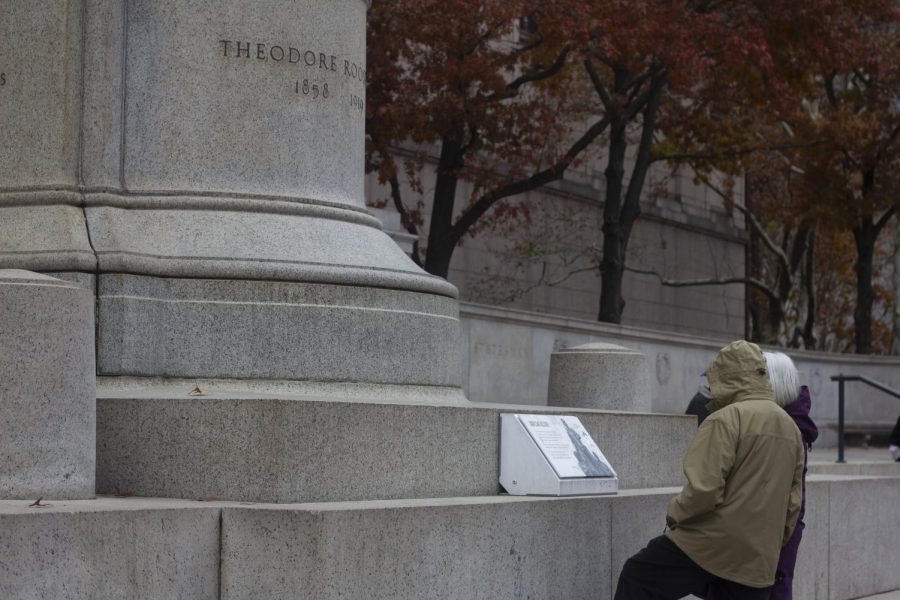Statues: To Commemorate or Condemn?
How America can properly remember its contentious heroes
Some places, such as the Museum of Natural History, have placed plaques in front of the statues explaining their history and giving context for the way a person or scene was depicted.
December 22, 2021
I remember learning in school about the great heroes of American history who shaped our nation’s path: Men and women who possessed a superior intellect, charisma, leadership or other attributes that allowed them to rise above their fellows and fundamentally change the course of our country’s history.
Figures like George Washington, Abraham Lincoln, Thomas Jefferson and Theodore Roosevelt were portrayed as heroes in textbooks who overcame tremendous obstacles and possessed few personal flaws.
As inspiring as they may seem, this is the exact problem that many American schools face with their over glorification of American figures that casts the dark side of such figures to the wayside. Maturing as an American in high school and college taught me about the other side of these figures, the often racist beliefs and attitudes they held that often ruined the lives of hundreds if not thousands of African Americans and other minorities in the country at the time.
As a country, we face the dilemma of how to reconcile the good deeds and historic significance of these figures with the horrific beliefs and actions committed by them. I believe that distinction lies with who left the U.S. better as a whole than it was before their time.
To teach an unbiased, comprehensive view of American history, students must learn about their successes and failures.
The Grayness of History
People must be judged by the contexts into which they were born. Robert Moses, for example, was born in a time and place where many Americans held racist views and used their positions of power to negatively affect the lives of non-whites. As the holder of numerous state and municipal positions at the same time, he often used his influence to choose low-income minority neighborhoods to destroy for highways, parks and urban renewal projects, and vocally opposed allowing Black World War II veterans from moving into Stuyvesant Town.
I do not condone Moses’s racist actions, but to paint him purely as a racist politician who desired to worsen the lives of non-white New Yorkers while ignoring his accomplishments of planning and constructing Fordham’s Lincoln Center campus, securing the construction of the Triborough Bridge and numerous others, and persuading the U.N. to select New York as their headquarters, ignores the ambiguity of his significance. Like the architectural company McKim, Mead & White decades before him, Moses shaped the modern landscape of New York in both good and bad ways.
While schools should teach students about the accomplishments of figures like Moses, they should also educate students about the sins and failures of these famous American figures as well. As the old saying goes, there are two sides to every coin; to teach an unbiased, comprehensive view of American history, students must learn about their successes and failures. Not doing so would not only be turning a blind eye to our country’s sins but doing a disservice to the descendants of those who suffered because of history’s wrongdoings.
Context Is Everything
Men such as Robert E. Lee and Stonewall Jackson should not be honored with statues, because they fought to destroy our country without adding anything of value to it at all. Similarly, officials like J. Edgar Hoover should not be honored, because he ordered illegal wiretaps and surveillance of civil rights leaders and attempted to blackmail politicians who crossed him.
These examples are easy. These Americans either degraded the nation or abused their power in a disgusting way. Yet, history is not always black and white. What do we do when a famous figure achieved great accomplishments for our country but also possessed awful attitudes and committed terrible actions by modern-day standards?
One recommendation I have seen proposed and implemented in cities, including New York, involves displaying plaques at the bases of morally ambiguous figures. Such plaques educate the public on the success and failures of the historical figures honored with a statue, building name, or similar sort of commemoration. In a way, one would capture not only the twin-sided nature of the flawed person but the twin-side nature of our nation’s history.
A successful implementation of this idea which can easily be replicated is the plaque in front of the Equestrian Statue of Theodore Roosevelt in front of the American Museum of Natural History in New York. While initially intended to honor Roosevelt’s devotion as a naturalist and love of conservation, the statue garnered sharp criticism for its depiction of Native American and African American men being depicted in a subservient manner to the horseback riding Roosevelt — something that has only been exacerbated by Roosevelt’s own problematic beliefs over racial superiority and eugenics.
We should judge those who came before the same way we hope to be judged in the future.
The displaying of plaques allows us to look history in the eye and reflect on our nation’s dark side of history. It does not sanitize history like middle school and high school textbooks do but allows the public to see the fallibility inherent in us, even the greatest among us.
Moreover, it shows how the progress of equality goes hand in hand with that of our moral beliefs on right and wrong. We should judge those who came before the same way we hope to be judged in the future.
The American experience revolves around trying to live up to those lofty ideals of liberty and equality proclaimed in the Declaration of Independence; the lives of the people captured in statues are reminders not only of our nation’s triumphs in a never-ending struggle to better our nation but the tragedies and mistakes that have marked our path.














